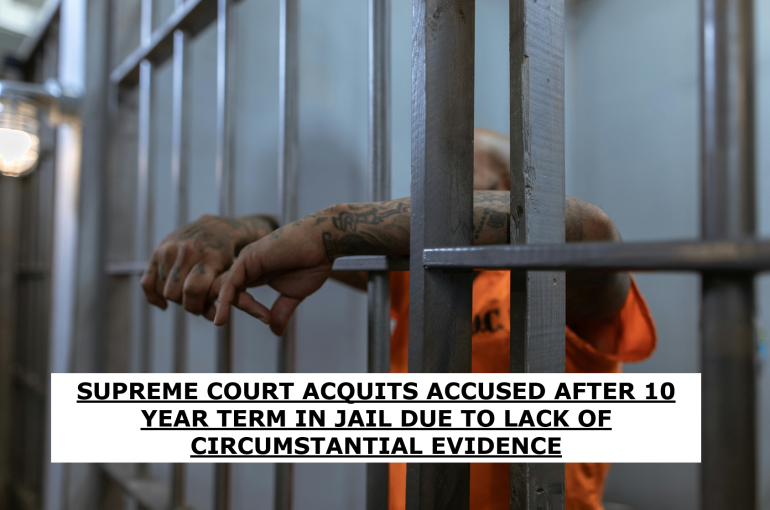SUPREME COURT ACQUITS ACCUSED AFTER 10 YEAR TERM IN JAIL DUE TO LACK OF CIRCUMSTANTIAL EVIDENCE
A two Judge Bench of the Hon’ble Supreme Court comprising of Justice Pankaj Mithal and Justice Ahsanuddin Amanullah passed a judgement dated 10.02.2025 in the matter of Ravi v. State of Punjab SLP (Crl) No.7712 Of 2022 wherein the Hon’ble Court held that the circumstances through which a conclusion is drawn by a Court should be fully established by the Prosecution.
Facts
The Appellant used to live with his first wife namely Jamni (now deceased) along-with his second wife namely Soma and their children since past 10-12 years. It was alleged that the Appellant along-with his second wife Soma strangulated Jamni and killed her. The case was initiated based on a Zero FIR lodged by Chaina Ram (PW-1) in Rajasthan who is the deceased’s brother, which was later transferred to Punjab. The Prosecution claimed that on 22.08.2014, Ravi, in collusion with his second wife murdered his first wife in Rayya Mandi, Punjab, by strangling her with a rope and transported her body to Rajasthan in a truck.
The Appellant was convicted by the Ld. Trial Court and also by the Hon’ble Punjab and Haryana High Court for murder of his wife on the basis of evidence that was available.
However, at the initial stages of the hearing, multiple witnesses came and gave evidence against the Appellant such as the deceased’s sister Rajo (PW-2) who was initially cited as an eyewitness but later turned hostile, stating that Jamni died of illness. Later, the brother (PW-1) and a cousin (PW-3) of the deceased also turned hostile and denied any knowledge of the crime. The post-mortem report indicated that Jamni’s cause of death was asphyxia due to hanging, with ligature marks on her neck. However, the doctor (PW-5) admitted in cross-examination that the marks could have been caused by tuberculosis or the long journey of the dead body. During investigation, Inspector Amolak Singh (PW-7) recovered a rope allegedly used in the crime. However, he admitted that similar ropes were easily available in the market, making it inconclusive evidence.
Issues
1) Whether the Appellant was rightly convicted by the Trial Court and High Court?
2) Whether there was enough circumstantial evidence to convict the Appellant?
Decision by the Hon’ble Supreme Court
The Court relied on the “Five Golden Principles” of circumstantial evidence established in Sharad Birdhichand Sarda v. State of Maharashtra (1984):
- The circumstances must be fully established.
- The facts must be consistent with guilt and exclude any other explanation.
- The circumstances must be conclusive in nature.
- They must exclude all possible hypotheses of innocence.
- The chain of evidence must be so complete that no reasonable doubt remains.
The Supreme Court found that these conditions were not met, as the Prosecution failed to establish a clear chain of evidence leading to Ravi’s guilt.
The State argued that under Section 106 of the Evidence Act 1872 (Burden of proving fact especially within knowledge), the Accused (Ravi) had the burden to explain the circumstances of his wife’s death since it occurred in their shared residence. However, the Hon’ble Court rejected this argument, citing Anees v. State Govt. of NCT (2024) SCC OnLine SC 757, which clarified that Section 106 does not relieve the Prosecution of its primary burden to prove guilt beyond a reasonable doubt.
On the other hand, the Appellant, in his Section 313 Code of Criminal Procedure (Power to examine the Accused) statement, claimed that his wife died naturally due to chronic tuberculosis, for which she was under treatment. The Apex Court noted that the Prosecution failed to disprove this claim. The Appellant backed his claim by producing medical records and by re-examining the doctor’s statement.
Since there were two conflicting explanations, the Apex Court ruled that the benefit of doubt must be given to the Accused.
Thus, the Supreme Court set aside the conviction and acquitted the Appellant, stating that the Prosecution had failed to prove guilt beyond reasonable doubt. The Hon’ble Bench ordered his immediate release, as he had already spent over ten years in jail. Moreover, the Hon’ble Court also appreciated the efforts of legal aid counsel who represented the Appellant.
Conclusion
The Hon’ble Court set aside the Judgement of the High Court dated 23.01.2019 and released the Appellant vide judgement dated 10.02.2025. This case highlights the importance of proving guilt beyond reasonable doubt in circumstantial evidence cases and reinforces that Section 106 of the Evidence Act does not absolve the Prosecution of its burden to prove the crime.
SAKSHI RAGHUVANSHI
SENIOR LEGAL ASSOCIATE
THE INDIAN LAWYER & ALLIED SERVICES
Please log on to our YouTube channel, The Indian Lawyer Legal Tips, to learn about various aspects of the law. Our latest video, titled ‘Legal Framework for Artificial Intelligence’ can be viewed at the link below:





































Leave a Reply